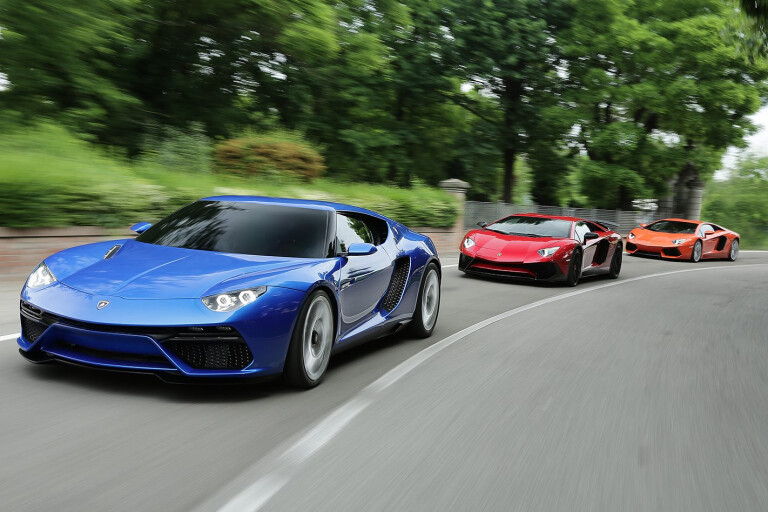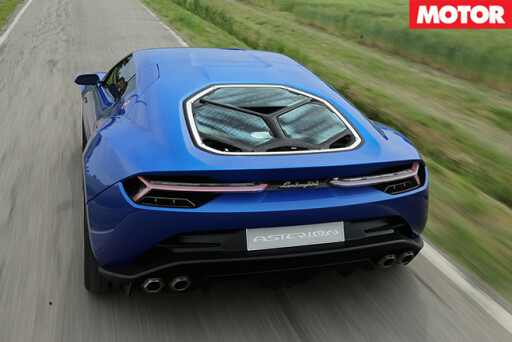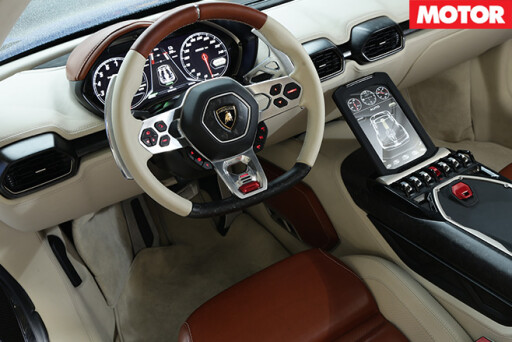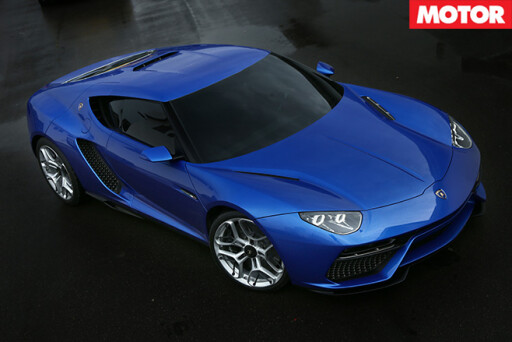
As far as conventional supercar engineering goes, Lamborghini’s Aventador SuperVeloce represents the pinnacle.
Its stunning Nürburgring lap time and the sheer ferocity of its performance proves that.
But conventional supercar engineering only has so much more to give. While there may be plenty of speed still to unlock in petrol power, it’s increasingly unlikely that emissions regulations will allow it to be unlocked.
Still, as the recent slew of hybrid hypercars from Porsche, Ferrari, McLaren and even Koenigsegg prove, batteries can be made to not only electrify the car but your senses as well, suggesting that petrol-electric performance might be the way to go, regardless of regulation.
It’s an approach Lamborghini is looking into closely. The Sant’Agata supercar maker made its ambitions clear with its stunning Asterion LP910-4 concept at last year’s Paris Motor Show, a car we’re driving today, but of more interest is the perfectly normal looking orange Aventador sitting silently next to the beautiful blue show car and radically bewinged Aventador SV.
 In complete contrast to Lamborghini’s usual style, this LP700-4 is no rowdier when on the move. The analogue rev counter lies dormant, yet Lamborghini director of research and development, Maurizio Reggiani, and I are humming along at 120km/h, grinning at each other like schoolboys.
In complete contrast to Lamborghini’s usual style, this LP700-4 is no rowdier when on the move. The analogue rev counter lies dormant, yet Lamborghini director of research and development, Maurizio Reggiani, and I are humming along at 120km/h, grinning at each other like schoolboys.
Nicknamed Tosca, after Puccini’s opera, this mule is Lamborghini’s solitary development prototype for its plug-in hybrid system, a bet on the future run on a shoestring budget. Despite being based on the larger of Lamborghini’s two super sports car, finding room for the hybrid system means that, like the Asterion, Tosca has downsized from the Aventador’s 6.5-litre V12 to the Huracán’s 5.2-litre V10.
Reggiani explains the concept further: “We have settled for electric front-wheel drive and petrol-fed rear-wheel drive. The third electric drive unit, which incorporates a starter motor and generator, is sandwiched between the 449kW V10 engine and the sequential seven-speed transmission. What this configuration gives us is on-demand four-wheel drive and a hybrid mode which fuses all powerplants irrespective of the state of charge”.
 This dual powertrain results in a combined power output of 669kW outstripping even the mighty Aventador SV by more than 100kW. But Reggiani is quick to add the ensuing penalty. “The whole assembly weighs over 200kg, which is much more than we saved by taking out the mechanical four-wheel drive system. In addition, the energy cells are still in need of improvement in terms of sustainable performance, charging time, degradation, the number of charge cycles, weight, size and cost.”
This dual powertrain results in a combined power output of 669kW outstripping even the mighty Aventador SV by more than 100kW. But Reggiani is quick to add the ensuing penalty. “The whole assembly weighs over 200kg, which is much more than we saved by taking out the mechanical four-wheel drive system. In addition, the energy cells are still in need of improvement in terms of sustainable performance, charging time, degradation, the number of charge cycles, weight, size and cost.”
The Asterion’s performance targets may only be hypothetical for now, but they offer a clear indication of the direction this project is going to take. The main focus is to achieve a zero-emission range of 50km, which Lamborghini believes will be mandatory for all new vehicles sold in the US and China before too long.
Mission number two is to the lower the brand’s fairly terrible average CO2 emissions, something the Asterion manages with a claimed average fuel consumption of 4.12L/100km and just 98g/km of CO2. However unlikely these figures are in the real world, it’s the on-paper stats that matter to regulators, and both numbers are significantly better than the Aventador’s claims of 16.0L/100km and 381g/km.

“We did not want to create a shape that is even more extreme than Huracán or Aventador,” says chief designer, Filippo Perini. “After all, this car points in a direction which is new for us. It is less about acceleration and top speed and more about environment-friendliness.”
While still clearly a Lamborghini, parked next to the overtly butch Aventador the Asterion looks very clean and almost subtle, with a hint of Miura. The interior, too, reflects the user-friendly nature of the concept, with ivory-over-brown leather and sparse aluminium accents replacing the liberally-applied alcantara and carbonfibre. Visibility is good, the seats are comfortable and all the main controls are logically arranged.
The main in-dash display is promising a range of 50km, but the state-of-charge meter says otherwise. Given large parts of the monocoque, suspension, steering and brakes are closely related to Lamborghini’s current range, it should be no surprise that the Asterion feels reasonably familiar, albeit handicapped by its ultra-wide footwear.
 The brittle ride also betrays its concept status, and the slow throttle response suggests that the promised electric boost is at this point only a paper tiger.
The brittle ride also betrays its concept status, and the slow throttle response suggests that the promised electric boost is at this point only a paper tiger.
By midday the Asterion desperately seeks attachment to the nearest plug, so we swap into Tosca for a more thorough evaluation of this technology’s talents. It’s clearly a mule – there’s lot of black tape and plenty of impromptu amendments.
Although it musters an extra 154kW over a standard Aventador, the plug-in hybrid is actually claimed to take one-tenth longer to accelerate from 0-100km/h and top speed is 30km/h down. Blame those extra 200kg, as well as the infancy of the electronic systems such as torque vectoring, eletronic throttle and e-boost.
The extra wide transmission tunnel separating driver and passenger, stuffed with high voltage battery pouches, provides a hint as to the extra heft, but despite the heavy load, in-gear acceleration is simply sensational. Floor the throttle and ESC assistance is required in first, second and third gear. No specific data is available, but it’s safe to assume that aggregate torque is somewhere closer to four figures.
The greatest hurdle facing Lamborghini’s electrified future, though, isn’t likely to be mastering the technology, but overcoming corporate finance. “Lamborghini can at best be a fast follower – we are too small and lack the funds to set trends,” states Lambo’s shrewd CEO, Stephen Winkelmann. “Do we believe in PHEV? Absolutely. Can we afford it? Absolutely not.”
 Having just signed off on the Urus SUV, Audi is reportedly reluctant to pour money into an expensive development project – a source at Audi tells us that in light of the expected tiny volumes, parts costs alone would exceed $115K per vehicle – with little guarantee of a return. Comments a board member from Ingolstadt: “After 2018, when the Urus starts to bring fresh cash to the table, we can talk about anything they like.”
Having just signed off on the Urus SUV, Audi is reportedly reluctant to pour money into an expensive development project – a source at Audi tells us that in light of the expected tiny volumes, parts costs alone would exceed $115K per vehicle – with little guarantee of a return. Comments a board member from Ingolstadt: “After 2018, when the Urus starts to bring fresh cash to the table, we can talk about anything they like.”
Winkelmann agrees: “The situation may change once the right technology is available at the right price. We are talking about the next-generation of sports cars here, not about next year or the year after. You don’t have to be an expert in reading the crystal ball to assume that a hybrid edition of Urus is on the cards. But when it comes to Huracán and Aventador, Lamborghini needs a tailormade concept that honours our chief brand values.”
What Winkelmann does not say is that these values rank performance and excitement well ahead of saving the planet. Reggiani sums it up with a smile: “We must do what Italians don’t do very well – be patient. But of course it does help to prepare for all eventualities.”

COMMENTS